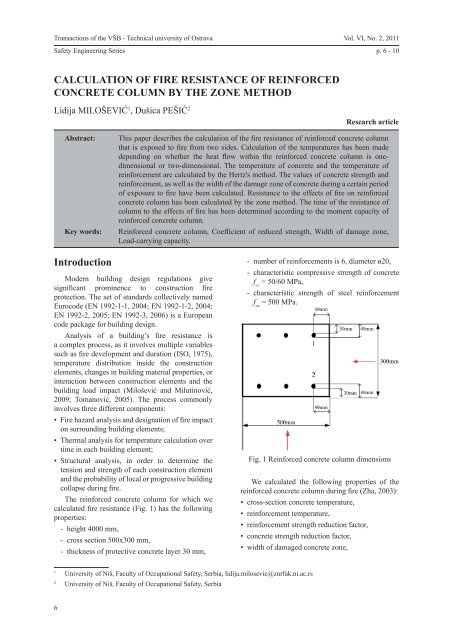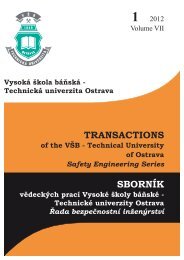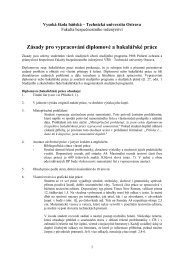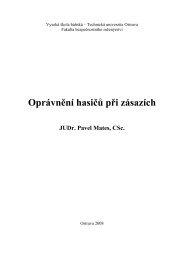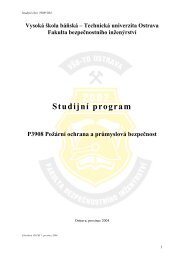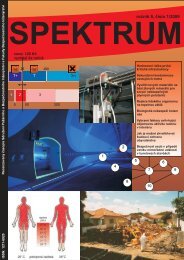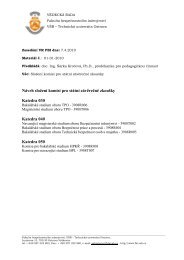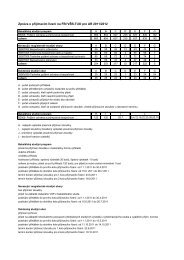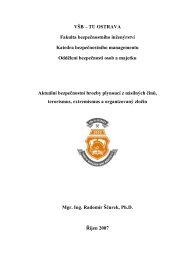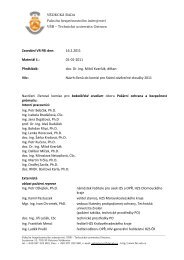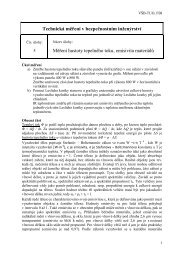Transactions - FBI - Vysoká Å¡kola báÅská - Technická univerzita ...
Transactions - FBI - Vysoká Å¡kola báÅská - Technická univerzita ...
Transactions - FBI - Vysoká Å¡kola báÅská - Technická univerzita ...
Create successful ePaper yourself
Turn your PDF publications into a flip-book with our unique Google optimized e-Paper software.
<strong>Transactions</strong> of the VŠB - Technical university of OstravaSafety Engineering SeriesVol. VI, No. 2, 2011p. 6 - 10CALCULATION OF FIRE RESISTANCE OF REINFORCEDCONCRETE COLUMN BY THE ZONE METHODLidija MILOŠEVIĆ 1 , Dušica PEŠIĆ 2Research articleAbstract:Key words:This paper describes the calculation of the fire resistance of reinforced concrete columnthat is exposed to fire from two sides. Calculation of the temperatures has been madedepending on whether the heat flow within the reinforced concrete column is onedimensionalor two-dimensional. The temperature of concrete and the temperature ofreinforcement are calculated by the Hertz's method. The values of concrete strength andreinforcement, as well as the width of the damage zone of concrete during a certain periodof exposure to fire have been calculated. Resistance to the effects of fire on reinforcedconcrete column has been calculated by the zone method. The time of the resistance ofcolumn to the effects of fire has been determined according to the moment capacity ofreinforced concrete column.Reinforced concrete column, Coefficient of reduced strength, Width of damage zone,Load-carrying capacity.IntroductionModern building design regulations givesignificant prominence to construction fireprotection. The set of standards collectively namedEurocode (EN 1992-1-1, 2004; EN 1992-1-2, 2004;EN 1992-2, 2005; EN 1992-3, 2006) is a Europeancode package for building design.Analysis of a building’s fire resistance isa complex process, as it involves multiple variablessuch as fire development and duration (ISO, 1975),temperature distribution inside the constructionelements, changes in building material properties, orinteraction between construction elements and thebuilding load impact (Milošević and Milutinović,2009; Tomanović, 2005). The process commonlyinvolves three different components:• Fire hazard analysis and designation of fire impacton surrounding building elements;• Thermal analysis for temperature calculation overtime in each building element;• Structural analysis, in order to determine thetension and strength of each construction elementand the probability of local or progressive buildingcollapse during fire.The reinforced concrete column for which wecalculated fire resistance (Fig. 1) has the followingproperties:- height 4000 mm,- cross section 500x300 mm,- thickness of protective concrete layer 30 mm,- number of reinforcements is 6, diameter ø20,- characteristic compressive strength of concretef cc= 50/60 MPa,- characteristic strength of steel reinforcementf ac= 500 MPa.Fig. 1 Reinforced concrete column dimensionsWe calculated the following properties of thereinforced concrete column during fire (Zha, 2003):• cross-section concrete temperature,• reinforcement temperature,• reinforcement strength reduction factor,• concrete strength reduction factor,• width of damaged concrete zone,1University of Niš, Faculty of Occupational Safety, Serbia, lidija.milosevic@znrfak.ni.ac.rs2University of Niš, Faculty of Occupational Safety, Serbia6


